With Offshore Europe getting ready to celebrate its 50th anniversary event, we take a look at some of the technological innovations in offshore wind power since Offshore Europe's inaugural event in 1973 – then known as Offshore Scotland. Selecting a series of wind power patents filed from 1973 onwards, we briefly consider the problems the inventors of these patents sought to overcome at the time of devising their inventions, providing a glimpse into some of the industry problems of the past.
The evolution of wind power technology has been on a remarkable journey of human ingenuity since 1973. People have harnessed the wind's energy to produce electricity for many years – the first wind turbines were invented by Charles F Bush in Ohio and James Blythe in Glasgow in the 1880s. However, it has only been since the late 20th century that wind power has played a significant role in the production of energy across the globe. In particular, since the first operational wind turbine was installed off the coast of Denmark in 1991, wind power has been able to leverage the stronger and more consistent winds found offshore. In the UK, the first offshore wind farm was opened in 2003 and there are now more than 2,500 offshore wind turbines operating in UK territorial waters, with many more in the pipeline. It is clear that offshore wind power will be a major player in the UK's energy mix in years to come.
1973
While most modern wind turbines are horizontal-axis, three-bladed designs, often referred to as the "Gedser design" invented by Johannes Juul in Denmark in the 1950s, this was not always the case. As shown by the patents below, for example, many other wind turbine designs were proposed before the three-bladed design dominated the market due to its compromise between energy yield, stability and weight.
In 1973, US Patent 3,867,067 was filed disclosing an invention relating to a vertical-axis wind turbine for generating electricity. The inventor of this patent sought to overcome the problem of wind resistance varying across different vanes due to differences in the angle of attack of air flow. The inventor's solution was to provide means to vary the surface area of the vanes to deflect the force of the wind at most appropriate time for increased power performance.
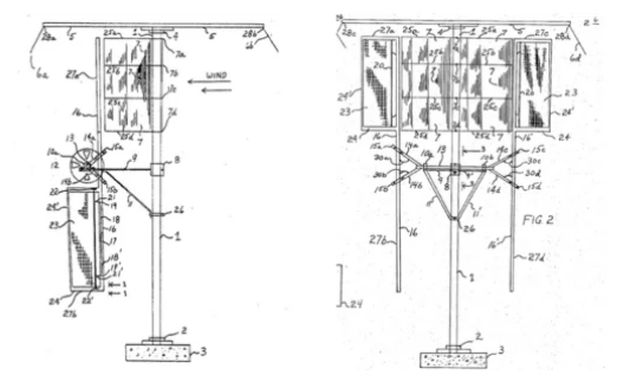
1983
In 1983, US Patent 4,537,559 was filed disclosing an improvement to a "Darrieus design" of wind turbine – invented by George Darrieus in France in the 1930s – including a vertical-axis wind turbine consisting of a number of curved aerofoil blades mounted on a rotating framework. The inventor of this patent sought to enhance the movement of the aerofoil blades by arranging the aerofoil blades in such a way to produce a venturi effect to increase the rotational speed of the aerofoil blades relative to the support hub.
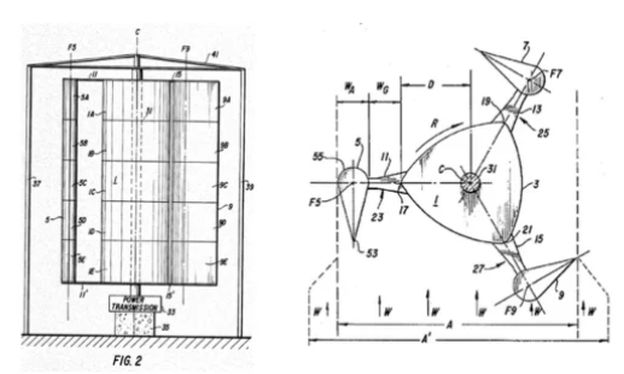
1993
In 1993, UK Patent 2,275,970 was filed describing a vertical-axis wind turbine including funnels for deflecting air flow to impinge squarely on the rotor blades. The inventor of this patent sought to reduce the size of vertical-axis wind turbines by providing a particular blade geometry, which, together with the funnel arrangement, allowed the overall size of the wind turbine to be reduced.
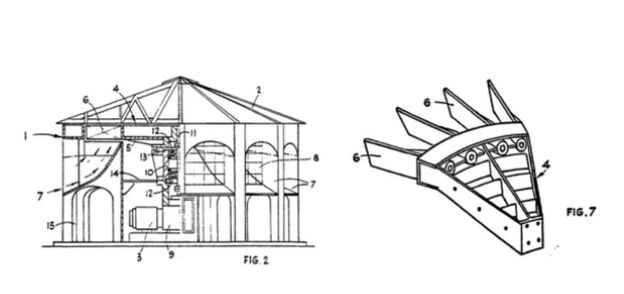
2003
In 2003, US Patent 7,282,808 was filed disclosing an improvement to a "Gedser design" of wind turbine including a gear box supported by a single double-row tapered roller bearing. The inventor of this patent sought to overcome challenges associated with the installation and maintenance of gear boxes. The inventor's solution was to use a single double-row tapered roller bearing for receiving radial, thrust and bending loads from the main shaft of the rotor. This allowed the main shaft to be supported by a single roller bearing and the supporting structure of the main shaft to be made more compact.
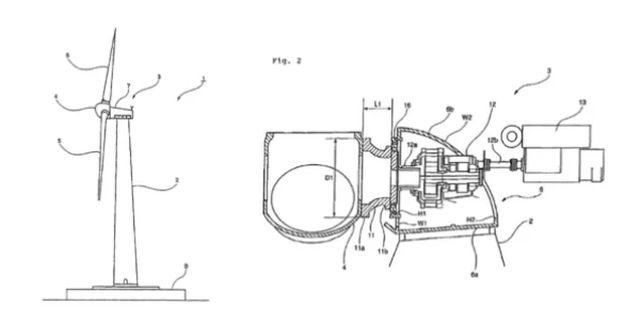
2013
In 2013, US Patent 9,279,413 was filed disclosing a bearing arrangement for a rotor hub of a horizontal axis wind turbine. The inventor of this patent sought to provide a bearing arrangement for supporting rotor blades of larger sizes. The inventor's solution involved placing the bearing arrangement as close to the centre of mass of the rotating parts as possible to reduce the static and dynamic bending moments on the bearing arrangement.
Owned by Siemens, this patent has been of great importance within the offshore wind industry in recent years, following Siemens's highly publicised multijurisdictional patent dispute with GE relating to GE's Haliade-X wind turbine.
In the US, proceedings concluded in 2022 with the court ruling that GE's Haliade-X wind turbine infringed Siemens patent. Somewhat unusually, however, the court ruled that GE would be allowed to continue supplying their Halidate-X wind turbines for certain offshore developments, although GE would be required to pay Siemens royalties of $60,000 for every megawatt of electricity produced using their Halide-X turbines.
Unlike the US proceedings, the related UK patent infringement case reached a different conclusion with the court finding that Siemens patent was invalid, which we discuss in detail in our article here.
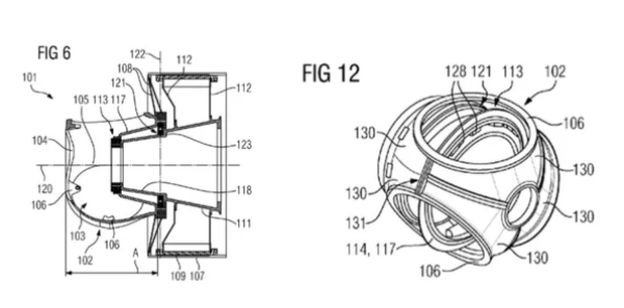
2023
As for patents filed in 2023, patents are typically published 18 months after filing therefore the latest inventions are yet to become publicly known.
Marks & Clerk is proud to be attending and exhibiting at SPE Offshore Europe. We look forward to connecting with global industry leaders at Europe's leading offshore energy event!
The content of this article is intended to provide a general guide to the subject matter. Specialist advice should be sought about your specific circumstances.

